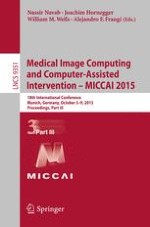2015 | OriginalPaper | Buchkapitel
Brain Tissue Segmentation Based on Diffusion MRI Using ℓ0 Sparse-Group Representation Classification
verfasst von : Pew-Thian Yap, Yong Zhang, Dinggang Shen
Erschienen in: Medical Image Computing and Computer-Assisted Intervention – MICCAI 2015
Aktivieren Sie unsere intelligente Suche, um passende Fachinhalte oder Patente zu finden.
Wählen Sie Textabschnitte aus um mit Künstlicher Intelligenz passenden Patente zu finden. powered by
Markieren Sie Textabschnitte, um KI-gestützt weitere passende Inhalte zu finden. powered by
We present a method for automated brain tissue segmentation based on diffusion MRI. This provides information that is complementary to structural MRI and facilitates fusion of information between the two imaging modalities. Unlike existing segmentation approaches that are based on diffusion tensor imaging (DTI), our method explicitly models the coexistence of various diffusion compartments within each voxel owing to different tissue types and different fiber orientations. This results in improved segmentation in regions with white matter crossings and in regions susceptible to partial volume effects. For each voxel, we tease apart possible signal contributions from white matter (WM), gray matter (GM), and cerebrospinal fluid (CSF) with the help of diffusion exemplars, which are representative signals associated with each tissue type. Each voxel is then classified by determining which of the WM, GM, or CSF diffusion exemplar groups explains the signal better with the least fitting residual. Fitting is performed using ℓ
0
sparse-group approximation, circumventing various reported limitations of ℓ
1
fitting. In addition, to promote spatial regularity, we introduce a smoothing technique that is based on ℓ
0
gradient minimization, which can be viewed as the ℓ
0
version of total variation (TV) smoothing. Compared with the latter, our smoothing technique, which also incorporates multi-channel WM, GM, and CSF concurrent smoothing, yields marked improvement in preserving boundary contrast and consequently reduces segmentation bias caused by smoothing at tissue boundaries. The results produced by our method are in good agreement with segmentation based on
T
1
-weighted images.
